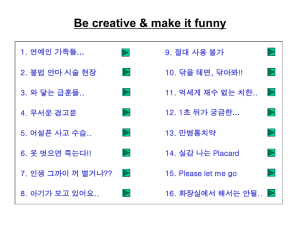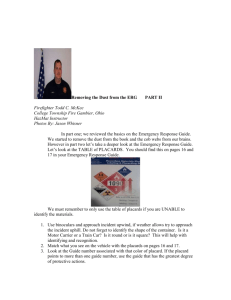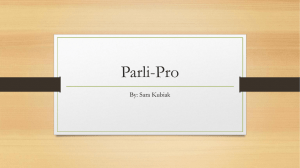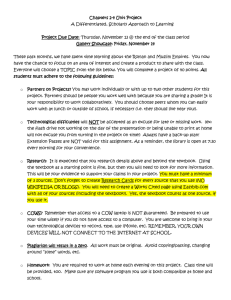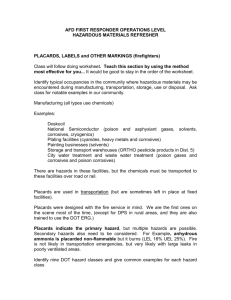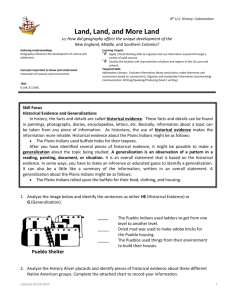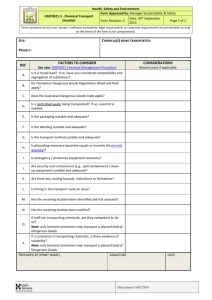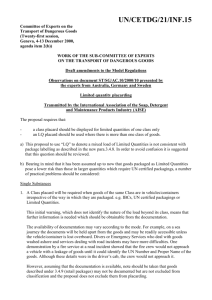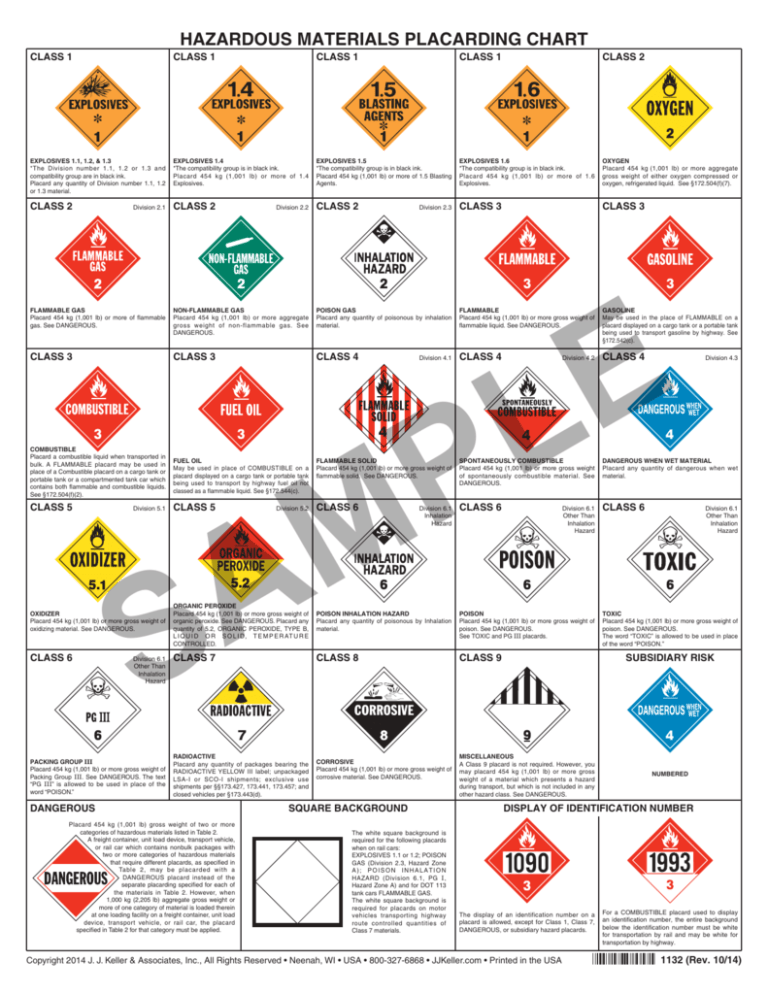
HAZARDOUS MATERIALS PLACARDING CHART
CLASS 1
CLASS 1
CLASS 1
CLASS 1
CLASS 2
✽
✽
EXPLOSIVES 1.1, 1.2, & 1.3
*The Division number 1.1, 1.2 or 1.3 and
compatibility group are in black ink.
Placard any quantity of Division number 1.1, 1.2
or 1.3 material.
EXPLOSIVES 1.4
*The compatibility group is in black ink.
Placard 454 kg (1,001 lb) or more of 1.4
Explosives.
EXPLOSIVES 1.5
*The compatibility group is in black ink.
Placard 454 kg (1,001 lb) or more of 1.5 Blasting
Agents.
EXPLOSIVES 1.6
*The compatibility group is in black ink.
Placard 454 kg (1,001 lb) or more of 1.6
Explosives.
OXYGEN
Placard 454 kg (1,001 lb) or more aggregate
gross weight of either oxygen compressed or
oxygen, refrigerated liquid. See §172.504(f)(7).
CLASS 2
CLASS 2
CLASS 2
CLASS 3
CLASS 3
Division 2.1
✽
✽
Division 2.2
Division 2.3
FLAMMABLE GAS
Placard 454 kg (1,001 lb) or more of flammable
gas. See DANGEROUS.
NON-FLAMMABLE GAS
Placard 454 kg (1,001 lb) or more aggregate
gross weight of non-flammable gas. See
DANGEROUS.
POISON GAS
Placard any quantity of poisonous by inhalation
material.
FLAMMABLE
Placard 454 kg (1,001 lb) or more gross weight of
flammable liquid. See DANGEROUS.
GASOLINE
May be used in the place of FLAMMABLE on a
placard displayed on a cargo tank or a portable tank
being used to transport gasoline by highway. See
§172.542(c).
CLASS 3
CLASS 3
CLASS 4
CLASS 4
CLASS 4
COMBUSTIBLE
Placard a combustible liquid when transported in
bulk. A FLAMMABLE placard may be used in
place of a Combustible placard on a cargo tank or
portable tank or a compartmented tank car which
contains both flammable and combustible liquids.
See §172.504(f)(2).
CLASS 5
Division 5.1
Division 4.1
P
M
A
E
L
Division 4.2
Division 4.3
FUEL OIL
May be used in place of COMBUSTIBLE on a
placard displayed on a cargo tank or portable tank
being used to transport by highway fuel oil not
classed as a flammable liquid. See §172.544(c).
FLAMMABLE SOLID
Placard 454 kg (1,001 lb) or more gross weight of
flammable solid. See DANGEROUS.
SPONTANEOUSLY COMBUSTIBLE
Placard 454 kg (1,001 lb) or more gross weight
of spontaneously combustible material. See
DANGEROUS.
DANGEROUS WHEN WET MATERIAL
Placard any quantity of dangerous when wet
material.
CLASS 5
CLASS 6
CLASS 6
CLASS 6
Division 5.2
Division 6.1
Inhalation
Hazard
Division 6.1
Other Than
Inhalation
Hazard
Division 6.1
Other Than
Inhalation
Hazard
ORGANIC
PEROXIDE
S
OXIDIZER
Placard 454 kg (1,001 lb) or more gross weight of
oxidizing material. See DANGEROUS.
CLASS 6
Division 6.1
Other Than
Inhalation
Hazard
PACKING GROUP III
Placard 454 kg (1,001 lb) or more gross weight of
Packing Group III. See DANGEROUS. The text
“PG III” is allowed to be used in place of the
word “POISON.”
ORGANIC PEROXIDE
Placard 454 kg (1,001 lb) or more gross weight of
organic peroxide. See DANGEROUS. Placard any
quantity of 5.2, ORGANIC PEROXIDE, TYPE B,
L I Q U I D O R S O L I D, T E M P E R AT U R E
CONTROLLED.
CLASS 7
RADIOACTIVE
Placard any quantity of packages bearing the
RADIOACTIVE YELLOW III label; unpackaged
LSA-I or SCO-I shipments; exclusive use
shipments per §§173.427, 173.441, 173.457; and
closed vehicles per §173.443(d).
DANGEROUS
Placard 454 kg (1,001 lb) gross weight of two or more
categories of hazardous materials listed in Table 2.
A freight container, unit load device, transport vehicle,
or rail car which contains nonbulk packages with
two or more categories of hazardous materials
that require different placards, as specified in
Table 2, may be placarded with a
DANGEROUS placard instead of the
separate placarding specified for each of
the materials in Table 2. However, when
1,000 kg (2,205 lb) aggregate gross weight or
more of one category of material is loaded therein
at one loading facility on a freight container, unit load
device, transport vehicle, or rail car, the placard
specified in Table 2 for that category must be applied.
POISON INHALATION HAZARD
Placard any quantity of poisonous by Inhalation
material.
POISON
Placard 454 kg (1,001 lb) or more gross weight of
poison. See DANGEROUS.
See TOXIC and PG III placards.
CLASS 8
CLASS 9
CORROSIVE
Placard 454 kg (1,001 lb) or more gross weight of
corrosive material. See DANGEROUS.
SQUARE BACKGROUND
The white square background is
required for the following placards
when on rail cars:
EXPLOSIVES 1.1 or 1.2; POISON
GAS (Division 2.3, Hazard Zone
A); POISON INHALATION
HAZARD (Division 6.1, PG I,
Hazard Zone A) and for DOT 113
tank cars FLAMMABLE GAS.
The white square background is
required for placards on motor
vehicles transporting highway
route controlled quantities of
Class 7 materials.
TOXIC
Placard 454 kg (1,001 lb) or more gross weight of
poison. See DANGEROUS.
The word “TOXIC” is allowed to be used in place
of the word “POISON.”
SUBSIDIARY RISK
MISCELLANEOUS
A Class 9 placard is not required. However, you
may placard 454 kg (1,001 lb) or more gross
weight of a material which presents a hazard
during transport, but which is not included in any
other hazard class. See DANGEROUS.
NUMBERED
DISPLAY OF IDENTIFICATION NUMBER
The display of an identification number on a
placard is allowed, except for Class 1, Class 7,
DANGEROUS, or subsidiary hazard placards.
Copyright 2014 J. J. Keller & Associates, Inc., All Rights Reserved • Neenah, WI • USA • 800-327-6868 • JJKeller.com • Printed in the USA
For a COMBUSTIBLE placard used to display
an identification number, the entire background
below the identification number must be white
for transportation by rail and may be white for
transportation by highway.
1132 (Rev. 10/14)
1132
HAZARDOUS MATERIALS PLACARDING CHART
§172.502 Prohibited and permissive placarding.
(a) Prohibited placarding. Except as provided in paragraph (b) of this section, no person may affix or display on a packaging, freight container, unit load device, motor vehicle or rail car —
(1) Any placard described in this subpart unless —
(i) The material being offered or transported is a hazardous material;
(ii) The placard represents a hazard of the hazardous material being offered or transported; and
(iii) Any placarding conforms to the requirements of this subpart.
(2) Any sign, advertisement, slogan (such as “Drive Safely”), or device that, by its color, design, shape or content, could be confused with any placard prescribed in this subpart.
(b) Exceptions. (1) The restrictions in paragraph (a) of this section do not apply to a bulk packaging, freight container, unit load device, transport vehicle or rail car which is placarded in
conformance with TDG Regulations, the IMDG Code or the UN Recommendations (IBR, see §171.7 of this subchapter).
(2) The restrictions of paragraph (a) of this section do not apply to the display of a BIOHAZARD marking, a “HOT” marking, a sour crude oil hazard marking, or an identification number on a
white square-on-point configuration in accordance with §§172.323(c), 172.325(c), 172.327(a), or 172.336(b) of this part, respectively.
(3) The restrictions in paragraph (a)(2) of this section do not apply until October 1, 2001 to a safety sign or safety slogan (e.g., “Drive Safely” or “Drive Carefully”), which was permanently
marked on a transport vehicle, bulk packaging, or freight container on or before August 21, 1997.
(c) Permissive placarding. Placards may be displayed for a hazardous material, even when not required, if the placarding otherwise conforms to the requirements of this subpart.
§172.504 General placarding requirements.
(a) General. Except as otherwise provided in this subchapter, each bulk packaging, freight container, unit load device, transport vehicle or rail car containing any quantity of a hazardous
material must be placarded on each side and each end with the type of placards specified in Tables 1 and 2 of this section and in accordance with other placarding requirements of this
subpart, including the specifications for the placards named in the tables and described in detail in §§172.519 through 172.560.
(b) DANGEROUS placard. A freight container, unit load device, transport vehicle, or rail car which contains non-bulk packages with two or more categories of hazardous materials that
require different placards specified in Table 2 of paragraph (e) of this section may be placarded with a DANGEROUS placard instead of the separate placarding specified for each of the
materials in Table 2 of paragraph (e) of this section. However, when 1,000 kg (2,205 pounds) aggregate gross weight or more of one category of material is loaded therein at one loading
facility on a freight container, unit load device, transport vehicle, or rail car, the placard specified in Table 2 of paragraph (e) of this section for that category must be applied.
(c) Exception for less than 454 kg (1,001 pounds). Except for bulk packagings and hazardous materials subject to §172.505, when hazardous materials covered by Table 2 of this section are
transported by highway or rail, placards are not required on—
(1) A transport vehicle or freight container which contains less than 454 kg (1001 pounds) aggregate gross weight of hazardous materials covered by Table 2 of paragraph (e) of this
section; or
(2) A rail car loaded with transport vehicles or freight containers, none of which is required to be placarded.
The exceptions provided in paragraph (c) of this section do not prohibit the display of placards in the manner prescribed in this subpart, if not otherwise prohibited (see §172.502), on
transport vehicles or freight containers which are not required to be placarded.
(d) Exception for empty non-bulk packages. Except for hazardous materials subject to §172.505, a non-bulk packaging that contains only the residue of a hazardous material covered by
Table 2 of paragraph (e) of this section need not be included in determining placarding requirements.
(e) Placarding tables. Placards are specified for hazardous materials in accordance with the following tables:
E
L
TABLE 1
Category of material (Hazard class or division number and
Placard design section
Placard name
additional description. as appropriate)
reference (§)
1.1........................................................................................................................................
EXPLOSIVES 1.1............................................................172.552
1.2........................................................................................................................................
EXPLOSIVES 1.2............................................................172.522
EXPLOSIVES 1.3............................................................172.522
1.3........................................................................................................................................
2.3........................................................................................................................................
POISON GAS................................................................172.540
DANGEROUS WHEN WET............................................172.548
4.3........................................................................................................................................
5.2 (Organic peroxide, Type B, liquid or solid, temperature controlled).......................
ORGANIC PEROXIDE..................................................172.552
POISON INHALATION HAZARD...................................172.555
6.1 (material poisonous by inhalation (see §171.8 of this subchapter))......................
7 (Radioactive Yellow III label only).................................................................................RADIOACTIVE 1............................................................172.556
P
M
A
RADIOACTIVE placards are also required for: All shipments of unpackaged LSA–I material or SCO–I; all shipments required by §§173.427, 173.441, and 173.457 of this subchapter to be
operated under exclusive use; and all closed vehicles used in accordance with §173.443(d).
1
TABLE 2
Category of material (Hazard class or division number and
Placard design section
Placard name
additional description. as appropriate)
reference (§)
1.4........................................................................................................................................
EXPLOSIVES 1.4............................................................172.523
1.5........................................................................................................................................
EXPLOSIVES 1.5............................................................172.524
EXPLOSIVES 1.6............................................................172.525
1.6........................................................................................................................................
2.1........................................................................................................................................
FLAMMABLE GAS........................................................172.532
NON-FLAMMABLE GAS...............................................172.528
2.2........................................................................................................................................
3...........................................................................................................................................FLAMMABLE.................................................................172.542
Combustible liquid.............................................................................................................COMBUSTIBLE..............................................................172.544
FLAMMABLE SOLID......................................................172.546
4.1........................................................................................................................................
4.2........................................................................................................................................
SPONTANEOUSLY COMBUSTIBLE ...............................172.547
5.1........................................................................................................................................OXIDIZER.......................................................................172.550
5.2 (Other than organic peroxide, Type B, liquid or solid, temperature controlled)....
ORGANIC PEROXIDE..................................................172.552
6.1 (other than material poisonous by inhalation).........................................................POISON........................................................................172.554
.....................................................
6.2........................................................................................................................................(None)..........................................................................
8...........................................................................................................................................CORROSIVE.................................................................172.558
CLASS 9 (see §172.504(f)(9))......................................172.560
9...........................................................................................................................................
ORM-D.................................................................................................................................(None)..........................................................................
.....................................................
S
(f) Additional placarding exceptions. (1) When more than one division placard is required for Class 1 materials on a transport vehicle, rail car, freight container or unit load device, only the
placard representing the lowest division number must be displayed.
(2) A FLAMMABLE placard may be used in place of a COMBUSTIBLE placard on —
(i) A cargo tank or portable tank.
(ii) A compartmented tank car which contains both flammable and combustible liquids.
(3) A NON-FLAMMABLE GAS placard is not required on a transport vehicle which contains non-flammable gas if the transport vehicle also contains flammable gas or oxygen and it is
placarded with FLAMMABLE GAS or OXYGEN placards, as required.
(4) OXIDIZER placards are not required for Division 5.1 materials on freight containers, unit load devices, transport vehicles or rail cars which also contain Division 1.1 or 1.2 materials and
which are placarded with EXPLOSIVES 1.1 or 1.2 placards, as required.
(5) For transportation by transport vehicle or rail car only, an OXIDIZER placard is not required for Division 5.1 materials on a transport vehicle, rail car or freight container which also contains
Division 1.5 explosives and is placarded with EXPLOSIVES 1.5 placards, as required.
(6) The EXPLOSIVE 1.4 placard is not required for those Division 1.4 Compatibility Group S (1.4S) materials that are not required to be labeled 1.4S.
(7) For domestic transportation of oxygen, compressed or oxygen, refrigerated liquid, the OXYGEN placard in §172.530 of this subpart may be used in place of a NON-FLAMMABLE GAS
placard.
(8) For domestic transportation, a POISON INHALATION HAZARD placard is not required on a transport vehicle or freight container that is already placarded with the POISON GAS placard.
(9) For Class 9, a CLASS 9 placard is not required for domestic transportation, including that portion of international transportation, defined in §171.8 of this subchapter, which occurs
within the United States. However, a bulk packaging must be marked with the appropriate identification number on a CLASS 9 placard, an orange panel, or a white square-on-point display
configuration as required by subpart D of this part.
(10)For Division 6.1, PG III materials, a POISON placard may be modified to display the text “PG III” below the mid line of the placard.
(11)For domestic transportation, a POISON placard is not required on a transport vehicle or freight container required to display a POISON INHALATION HAZARD or POISON GAS placard.
(g) For shipments of Class 1 (explosive materials) by aircraft or vessel, the applicable compatibility group letter must be displayed on the placards, or labels when applicable, required by
this section. When more than one compatibility group placard is required for Class 1 materials, only one placard is required to be displayed, as provided in paragraphs (g)(1) through (g)(4)
of this section. For the purposes of paragraphs (g)(1) through (g)(4), there is a distinction between the phrases explosive articles and explosive substances. Explosive article means an article
containing an explosive substance; examples include a detonator, flare, primer or fuse. Explosive substance means a substance contained in a packaging that is not contained in an article;
examples include black powder and smokeless powder.
(1) Explosive articles of compatibility groups C, D or E may be placarded displaying compatibility group E.
(2) Explosive articles of compatibility groups C, D, or E, when transported with those in compatibility group N, may be placarded displaying compatibility group D.
(3) Explosive substances of compatibility groups C and D may be placarded displaying compatibility group D.
(4) Explosive articles of compatibility groups C, D, E or G, except for fireworks, may be placarded displaying compatibility group E.
See §172.505 for placarding subsidiary hazards.
Copyright 2014 J. J. Keller & Associates, Inc., All Rights Reserved • Neenah, WI • USA • 800-327-6868 • JJKeller.com • Printed in the USA
1132 (Rev. 11/14)
1132

